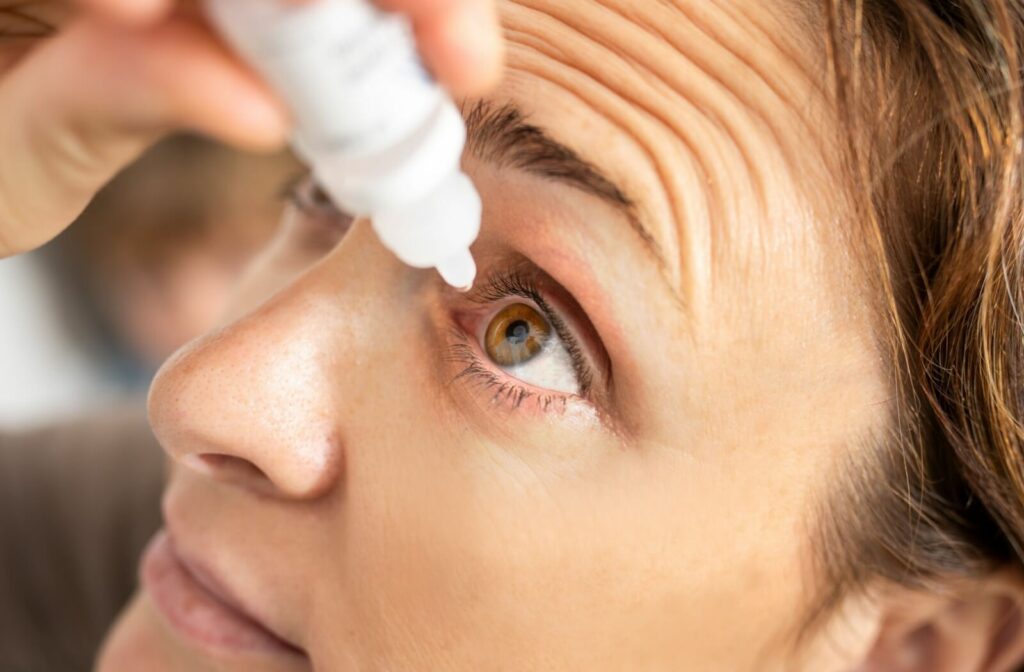Dealing with dry, scratchy, or burning eyes every day is no small feat. Throw in blurry vision and light sensitivity, and it can start to feel like an uphill battle. Meibomian gland dysfunction (MGD) can contribute significantly to these bothersome issues.
How long meibomian gland dysfunction lasts depends on the underlying cause, but it can range from a short-term problem to a chronic condition requiring ongoing management.
Whether you’re struggling to manage symptoms or curious about treatment options, your optometrist can walk you through the essentials of MGD and get you feeling better sooner.
The Role of the Meibomian Glands
Hidden along the edges of your upper and lower eyelids are meibomian glands, dozens of tiny powerhouses responsible for producing the oil in your tear film. This oil plays a crucial role in preventing your tears from evaporating too quickly, maintaining hydration and clarity for your eyes.
When functioning normally, these glands work 24/7 to keep your eyes protected and comfortable. However, when their delicate balance is disrupted, your tear film becomes compromised. This can leave your eyes feeling dry, irritated, and prone to discomfort.
What Is Meibomian Gland Dysfunction?
Meibomian gland dysfunction occurs when these glands either become blocked, inflamed, or fail to produce enough oil for your tear film. This disrupts the oil balance in your tears, leading to quicker evaporation and contributing to dry or painful eyes.
Some common culprits of MGD include:
- Age-related changes in oil production
- Environmental factors like wind, smoke, or dry air
- Certain medications impacting gland function
- Health conditions such as rosacea, diabetes, or autoimmune disorders
- Poor nutrition and diet
When meibomian glands can’t function properly, it often results in evaporative dry eye, a condition marked by persistent discomfort that can demand near-constant attention.
Depending on the underlying cause, MGD could either be a temporary condition or require long-term management to keep symptoms at bay.
The Warning Signs of MGD
Identifying meibomian gland dysfunction early is one of the best ways to counter its effects, especially since its symptoms tend to worsen over time. Key indicators of MGD include:
- A burning or itching sensation in your eyes
- Red, inflamed eyelids
- Blurred vision that worsens with prolonged screen use
- Excessive tearing or watery eyes
- Sensitivity to light
These symptoms can interrupt your daily life. If any of these sound familiar, it may be time to consult an eye care professional for further evaluation.
Tools & Treatments to Manage MGD
Effectively addressing meibomian gland dysfunction calls for a combination of at-home care and in-office treatment. From boosting your nutrition to advanced clinical therapies, here are some of the best ways to tackle MGD and find relief sooner:
Consider Your Nutrition
Healthy tears begin with the nutrients you take in. There’s some evidence that omega-3 supplements can reduce eye inflammation while improving the quality of your tear film if you lack this vital nutrient. This makes omega-3s a common go-to for alleviating MGD-related symptoms.
Make sure to check with your optometrist for supplement recommendations tailored to your needs.
Eye Drops
For temporary relief, preservative-free artificial tears can work wonders for soothing dry eye symptoms.
Prescription-strength options like RESTASIS or Xiidra go one step further by reducing tear inflammation and supporting overall tear production, providing longer-lasting relief.

TearCare
TearCare is an innovative system designed to gently heat and massage the eyelids, clearing blockages in the meibomian glands.
It uses small wearable devices to apply warmth, which melts away thickened oils. This 15-minute procedure is followed by a gentle eyelid massage to reset your glands for better performance. It’s comfortable, efficient, and offers noticeable improvements immediately after treatment.
OptiLight
When a deeper, more targeted solution is needed, OptiLight by Lumenis offers a way to tackle MGD at its root.
OptiLight uses intense pulsed light (IPL) therapy to reduce inflammation and improve meibomian gland function. During the procedure, gentle light pulses are applied to the area surrounding the eyes, melting away blockages that contribute to gland dysfunction.
Quick and non-invasive, OptiLight sessions only take a few minutes per eye, with most patients noticing improvements after only a few recommended treatments.
Is OptiLight Covered by Insurance?
OptiLight is considered an elective procedure and is not typically covered by insurance. You should consult with your optometrist or healthcare provider to discuss costs and payment options, as some clinics may offer help to make the treatment more accessible.
Look Forward to Lasting Comfort
Managing a condition like meibomian gland dysfunction can feel overwhelming, but it doesn’t have to be. There are solutions to help regain comfort in your daily life and promote long-term eye health. Whether it’s through dietary support, advanced treatments, or in-office therapies, relief is within reach.
Don’t wait for MGD to worsen. Book your appointment with Bethel Vision Care today to explore your options and take the first step toward healthier, more comfortable eyes. With our technology-focused approach and passionate eyecare team, we can guide you toward the relief you’ve been waiting for.



